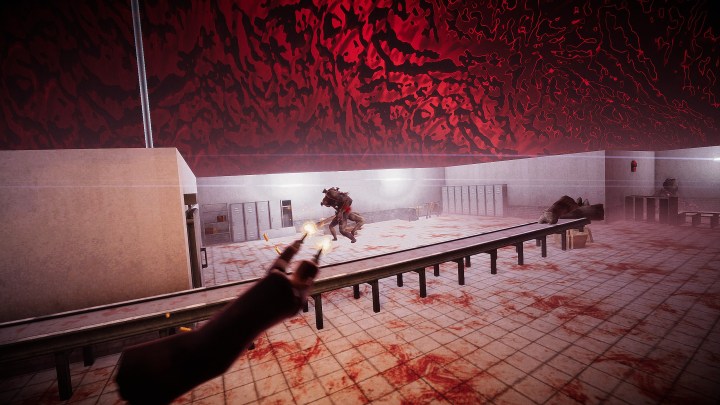“El Paso, Elsewhere is an intense, personal indie shooter that you'll want to see through to the end.”
- Purposeful old-school aesthetic
- Gripping, emotional narrative
- Incorporates themes into gameplay
- Intense Max Payne-inspired gunplay
- Wonky hit detection
- Out of place boss fights
At first, I thought El Paso, Elsewhere’s intentionally old-school style would be off-putting.
For a game with such a strong narrative focus, it felt weird for cutscenes to play out in a low-polygon style where the characters wouldn’t emote or move much. It also plays just like Max Payne and other early third-person shooters, rather than the more refined games in the genre from recent years like Outriders. The more I played, the more I came to accept that these choices weren’t just intentional, but the very heart of the project.
That’s not to say it’s a perfect experience; sometimes, all that purposeful jank does get in the way of a stylish shootout. Still, El Paso, Elsewhere‘s early 2000s aesthetics are crucial to maintaining the oddball shooter’s otherworldly feeling as players descend further into its main character’s literal and personal hell. What starts as a supernatural, neo-noir tribute to genre greats like Max Payne and Blade morphs over time into an intimate story about abuse. Clearly a very personal project from Strange Scaffold’s Xalavier Nelson Jr., the rough edges of El Paso, Elsewhere are what make it a beautiful, must-play indie.
You keep going
The initial premise of El Paso, Elsewhere is simple enough: James Savage is a monster hunter, his ex-girlfriend Draculae is a vampire, and he has to kill her to stop a cataclysmic event. Many of the older games El Paso, Elsewhere shares its aesthetic with might not have gone much further than that with the premise. But, like the Max Payne games, the personal struggles of its main character ground a story that you’ll want to see all the way through, despite the game’s rugged visual style.
It’s an emotional story that’s hard to put down …
El Paso, Elsewhere is a story about vampirism in more ways than one. The further James descends, the more the layers of his relationship and history with Draculae are pulled back. I learned more about how James had abused drugs in the past, something I, as the player, had to force him to relapse on whenever I healed during my journey. His relationship with Draculae seems sweet, though tragic, at first, only for it to become clear that it was a destructive and abusive relationship built around chasing a calming sense of love that had long since dissipated. The further James descends into the 50 floors beneath the supernatural El Paso motel the game takes place in, the more unhinged the experience gets.
It’s here where the low-poly aesthetics shine. Objects are recognizable but also blurry and untextured. Levels will shift form as James makes his way through them, and sometimes, cutscenes that are supposed to take place on an elevator between levels will instead take the form of a motel room or desert. It’s trippy, mind-bending, and sometimes nonsensical, but that all puts me in the mindscape of James in his excruciating journey.

It’s an emotional story that’s hard to put down but shows how personal this tale is to its developer. Xalavier Nelson Jr. voices James and breaks the fourth wall often, so a lot of the time, the developer is speaking directly to the player.
These struggles are highlighted, but there’s also an undercurrent of hope and encouragement through small things like the death message being “you keep going” instead of “you died.” Indie games that deal with complex emotional topics aren’t new, but El Paso, Elsewhere tells its story in a way that’s somehow both fantastical and humanistic. It kept me playing through the end and all of El Paso’s ups and downs.
More than Max Payne
James’ captivating descent toward Draculae is split into levels that start out looking like motel rooms and hallways but get increasingly weirder. Typically, these levels have players blasting through enemies as they save hostages and sometimes fight a powerful boss. It’s immediately noticeable at first glance that El Paso, Elsewhere is greatly inspired by Remedy Entertainment’s older Max Payne games. From pistols to shotguns to Uzis, plethora features a plethora of weapons that can quickly shred apart enemies at their disposal as they drive around and even slow down time to pull off perfect shots. El Paso, Elsewhere is a style of third-person shooter that hasn’t been made in a while, but it does find small ways to update the gameplay to make it more enjoyable.

Ranged attacks are relatively slow and only come from a couple of enemies. It’s rare to be ambushed and quickly killed by an enemy like it sometimes is in those older Max Payne games. The beacons of light that shoot up from each objective also mean it’s nearly impossible to get lost, as most levels lack roofs.
El Paso, Elsewhere’s gameplay makes me feel like a badass as I dive into a room and take out multiple enemies at once, but James is pretty frail and ammo is scarce, so the tide can quickly turn against him. It feels more “floaty” than most contemporary third-person shooters, but it reflects James’s fragile and weightless mental state through gameplay.
I couldn’t help but feel bad for what I was doing to James every time I used pills to heal him, encouraging his addictions so that I could see the end of this tragic story. I guess I wasn’t much better than Draculae in that way.
Going old-school
I always appreciate a game that finds clever ways to intertwine its narrative and gameplay, although the sometimes intentional friction of this third-person shooter does occasionally cause problems. The most significant issues are that James’ hitbox is wonky up close, and the audio and visual indications that James has been hit weren’t clear when I was running around constantly firing off weapons. That led to unintentional deaths when I was unaware of the damage I took in certain situations.

You’ll want to fiddle with the camera settings before you start too, as it tends to get stuck too often for the game’s wall-filled levels. Thankfully, I could adjust how the camera’s height was offset, and after I did that to bring it further down and closer to James, the gameplay experience was much better. The almost Soulslike design of the boss fights also feels like a mismatch with the Max Payne-style gameplay, and those foes sometimes get stuck in parts of the environment.
These issues do show the dangers of embracing old-school design; there’s a reason the industry innovated on and improved things like animation, hit indication, and camera angles. Still, the positives across narrative and gameplay far outweigh any of the technical issues (or intentional decisions) I had with El Paso, Elsewhere.
Once you understand what the game’s chilling, intimate story is saying and how it’s reinforced by gameplay and aesthetics, you’ll have a hard time putting it down. El Paso, Elsewhere is one of the most captivating indies of the year. It might make you uncomfortable, but that’s very much the point.
El Paso, Elsewhere was reviewed on PC.





